Need a creative spark for your sketchbook? Try quotes like “Creativity is intelligence having fun,” or “If it’s wonky—cool. That’s expressive, that’s art.” Funny ideas like “Draw while you’re on the toilet” remind everyone art can happen anywhere. “Warhol’s Law: If one drawing looks okay, ten look awesome,” encourages more doodling, not less. “Share your pages, share your light,” and “Let your curiosity lead your pen,” celebrate imperfection and playful joy. Stick around for even more inspiration!
Key Takeaways
- Embrace imperfection—your sketchbook thrives on wobbly lines, creative freedom, and happy accidents that make every page unique.
- Let playful exploration guide you; treat your sketchbook as a space for joyful experimentation and wild, unfiltered ideas.
- Celebrate your individuality by showcasing personal handwriting, doodles, and sketches that capture authentic emotions and moments.
- Use community inspiration—share pages, learn from peers, and remember that art is for everyone, not just the “talented” few.
- Sketch anywhere, anytime—consistent doodling and spontaneous drawing unlock creativity, build skills, and make each page a visual diary.
Creativity Is Intelligence Having Fun
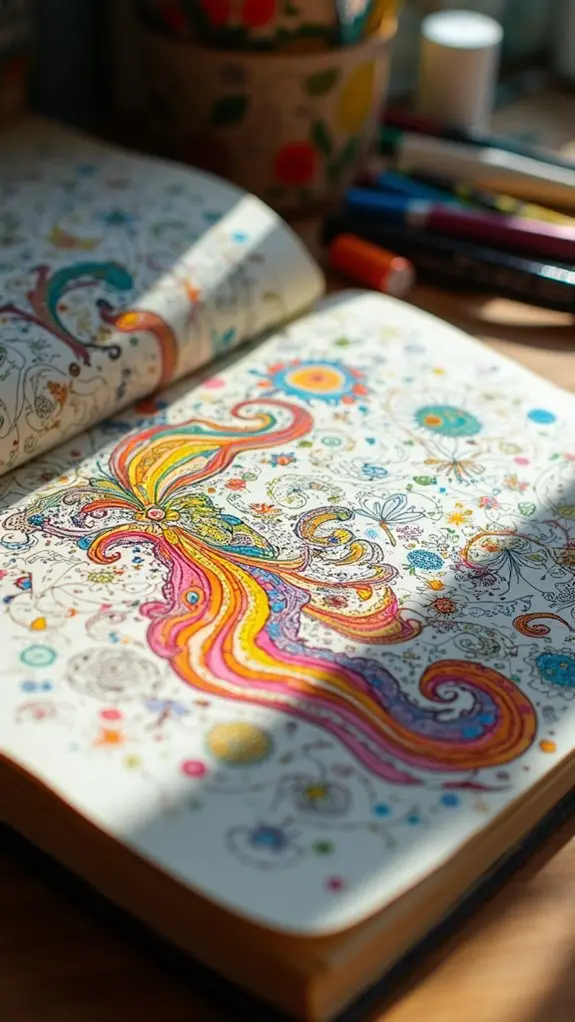
Creativity has a sneaky way of turning ordinary thoughts into something wild and unexpected. Einstein once said, “Creativity is intelligence having fun,” and honestly, that quote feels like giving your brain a party hat and a handful of crayons.
For artists, this idea opens the door to playful exploration, where it’s not just about following boring rules but letting curiosity run the show. Joyful experimentation takes center stage, with each doodle or sketch offering a chance to laugh about mistakes and get a little braver.
When artists invite fun into their process, they dodge perfectionism, and suddenly, the page is a playground. That’s when the weirdest, most fantastic ideas show up—ones that never would have existed if things stayed too serious.
If It’s Wonky — Cool. That’s Expressive, That’s Art
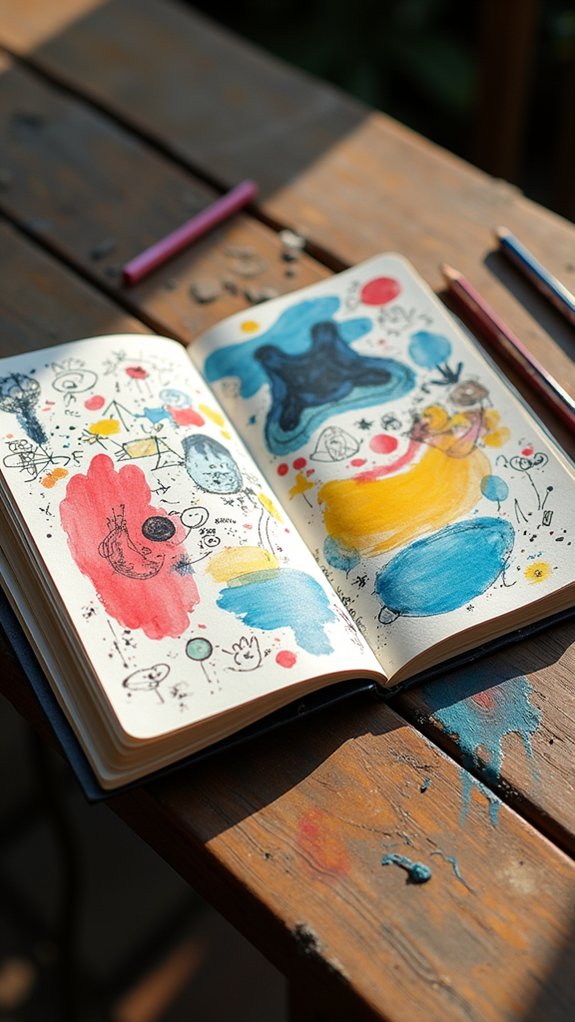
Sometimes, the best part of a sketch is the wobbly line that didn’t go where you planned—a total happy accident.
Embracing these little “mistakes” shows that the beauty in art often comes from flaws, not from everything looking perfect.
Instead of hiding quirks, bold artists use them to show who they are, letting their unique style shine through every wonky edge and smudge.
Embracing Artistic Imperfection
Imperfection in art isn’t just allowed—it’s actually pretty awesome. When artists let go of the idea that everything has to look perfect, something magical happens: artistic freedom kicks in.
That means paint splatters, wonky lines, and a doodle that kind of looks like a cat (but also maybe like a loaf of bread) are not mistakes—they’re part of creative exploration.
Sure, a carefully measured drawing is cool, but a squiggly, off-balance sketch has its own wild energy. Every unexpected wobble adds personality, showing the artist’s individuality.
When artists stop worrying about getting things exactly right, they start making stuff nobody else could. It’s like turning the “oops” moments into the “wow, check this out!” moments.
Now that’s some true expressive magic.
Finding Beauty in Flaws
Let’s be real—wonky lines, doodles that don’t follow the rules, and accidental paint splats aren’t just mistakes; they’re basically the secret sauce of awesome art. When artists start embracing quirks, suddenly, beauty authenticity bursts through every page. Forget perfection. A wobbly face or a lopsided tree gives personality—like the time your dog’s ear flopped inside out, and it was somehow even cuter. Art with flaws feels lively and honest, so sketchbooks become unique stories, not just “good drawings.” Here’s how finding beauty in flaws can make art cooler:
| Flaw | What It Adds | Why It’s Awesome |
|---|---|---|
| Crooked lines | Movement and energy | Feels more alive |
| Splotchy colors | Texture and surprise | Memorable moments |
| Asymmetrical shapes | Character and story | Shows individuality |
| Patchy shading | Mood and depth | Builds mystery |
| Messy outlines | Playful vibe | Adds spontaneity |
Expressing Yourself Boldly
Crank up the volume on those wild, wonky doodles—because bold expression in art is where the real magic happens.
When a drawing goes a little sideways, don’t sweat it; Danny Gregory would say that’s where your personality shines through!
Artistic freedom is about letting go of perfection and just seeing where your pencil takes you. That squiggly line you thought was a mistake? Maybe it’s actually creative exploration in action.
Every “flaw” is just a snapshot of your journey—something that makes your art feel fresh and alive.
The sketchbook is your zone to be silly, take risks, and surprise yourself.
Draw While You’re on the Toilet
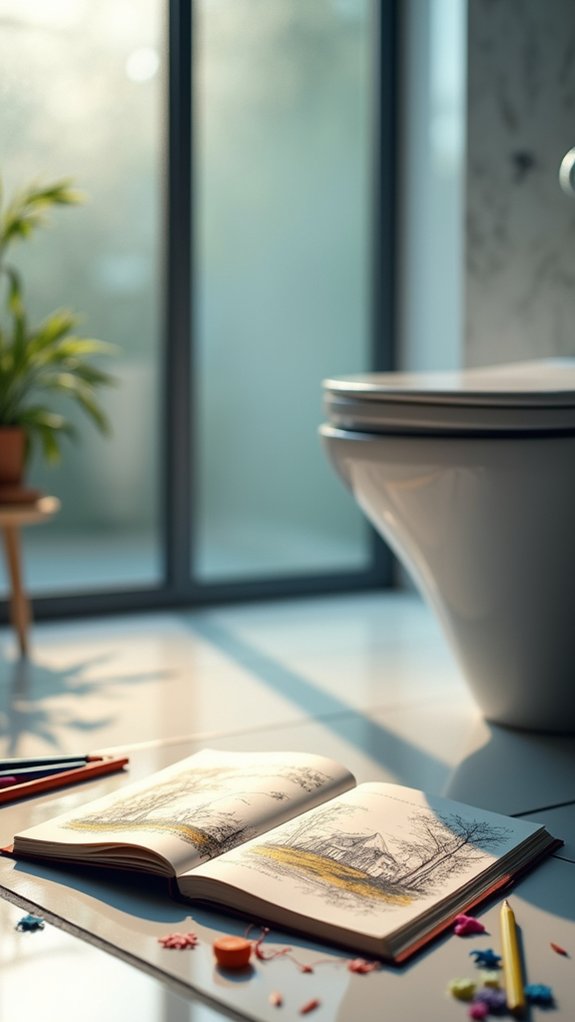
Envision this: someone grabs their sketchbook and a pen before heading into the bathroom, ready to turn an ordinary toilet break into a burst of creativity.
It sounds silly, but drawing on the toilet is a real thing—think of it as prime time for toilet doodles and spontaneous sketches. Instead of scrolling on your phone, imagine letting weird and wonderful ideas flow right onto the page.
The bathroom might not be an art studio, but that’s the fun of it. This goofy setting helps people ditch perfectionism and just have fun. Art doesn’t need fancy tools or a special place—any moment, even bathroom breaks, can spark inspiration.
Sometimes, the oddest spots create the coolest doodles you’ll make all week.
Warhol’s Law: If One Drawing Looks Okay, Ten Look Awesome
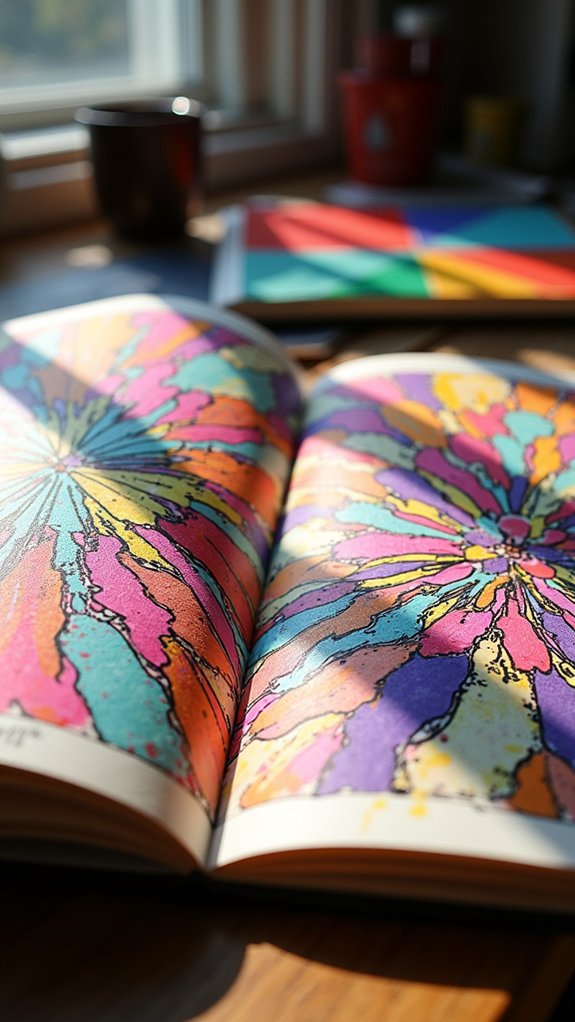
Warhol’s Law is proof that sometimes, more really is more—especially when it comes to sketching. If you’ve ever put down your pencil after one drawing, wondering if it’s any good, Warhol would tell you: do nine more!
Artistic exploration isn’t about making one perfect drawing—it’s about filling a whole page (or ten!) with creative experimentation. By focusing on making lots of drawings, artists loosen up, discover new techniques, and maybe even stumble on a wild new style they love.
Here’s why diving into quantity can spark your imagination:
- Boosts confidence and kills perfectionism
- Reveals happy accidents and hidden talents
- Makes practice feel playful, not stressful
- Turns mistakes into learning moments
- Helps spot patterns in your evolving style
Try it—let your sketchbook explode with ideas!
You Don’t Need to Make Art Alone in a Garret
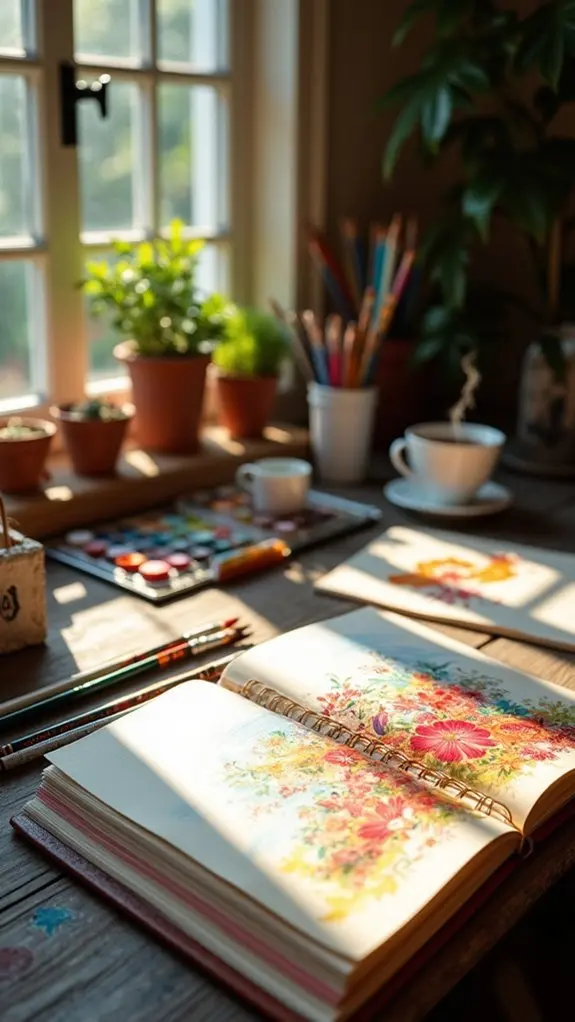
Making art doesn’t mean you have to sit by yourself in a lonely attic, surrounded by dusty books and empty snack wrappers.
There’s a real power in teaming up, trading ideas, and sharing sketches with other artists—sometimes, the wildest creativity sparks from those connections.
It’s amazing how much fun, encouragement, and fresh inspiration can show up when artists share their journeys together.
Power of Artistic Community
Even though movies often show lonely artists painting in dim attics, real creativity actually thrives when people come together.
Being part of an artistic community is like joining a superhero team—everyone’s powers boost each other! Artistic collaboration isn’t just about swapping pens or paint; it’s about connecting with others, finding community support, and discovering new ways to grow.
Sketchbook Skool reminds artists that creativity loves company and friendship. If you step out of your comfort zone and interact with fellow creators, you might find:
- More fun in shared art challenges
- Helpful, honest feedback (no grumpy critics allowed)
- New friends who inspire and motivate
- Confidence to try wild new techniques
- Freedom to be imperfect, goofy, and experiment
Friendships in art can turn solo sketches into unforgettable adventures!
Collaborative Creative Processes
Although some people picture artists huddled in lonely rooms with only their ideas for company, the truth is, creativity loves company way more than cobwebs.
Collaborative creative processes bring fresh energy to any sketchbook. By using collaborative techniques, like group challenges or shared sketch pages, artists discover new tricks and styles they never thought to try.
Community engagement isn’t just about chit-chat; it’s about building a team that pushes you to grow and experiment. Working alongside others gives artists feedback that’s actually helpful—not just “great job!” but real advice that can make their art better.
Plus, being part of a group project, like the ones at Sketchbook Skool, adds a sense of fun, accountability, and belonging. Spiders aren’t invited—just friends.
Sharing Artistic Journeys
Why hole up in a dusty attic when there’s a whole world of artists to share the journey with? It’s way more fun—and inspiring—to sketch, paint, or doodle while learning from others.
The greatest artists, like van Gogh and his friends, swapped ideas and stories, not just paintings. These days, you don’t have to go it alone, either. Sketchbook Skool, for instance, is all about community.
Want to get started? Try these ideas:
- Join community workshops for real-life creative buzz.
- Look for artistic mentorship—it’s like leveling up with a coach.
- Immerse yourself in group projects, and watch your style stretch in cool ways.
- Share pages on social media, and collect honest, helpful feedback.
- Meet friends who turn art into an everyday adventure.
Sketchbooks as Witnesses to Our Lives
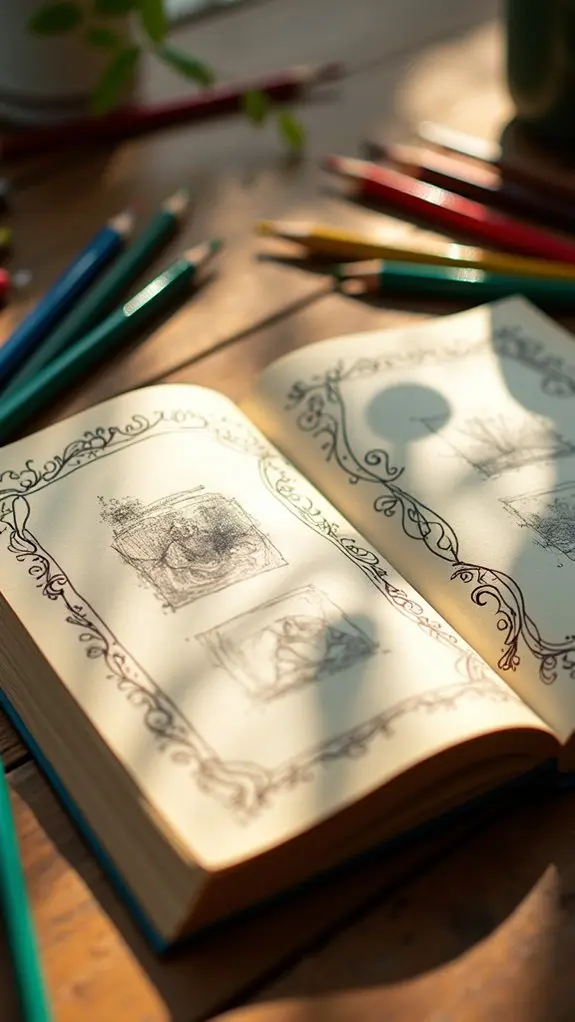
When someone flips open a sketchbook, it’s almost like peeking into a secret diary that doesn’t just use words. Each page carries a piece of the artist’s day—maybe a rushed drawing during lunch or a midnight burst of color while everyone sleeps. Some people think sketchbooks are only about drawing, but really, they capture sketchbook journeys and emotional reflections, becoming silent witnesses to everything from boredom to heartbreak. Vincent van Gogh saw his sketchbook as his most faithful companion, and Eugene Delacroix used his tiny notebook to trap wild thoughts and quiet wishes.
Here’s a table to show just how much a sketchbook can mean:
| Moment Caught | Feeling Left Behind |
|---|---|
| Crumpled receipt glue | Sudden sadness |
| Quick subway sketch | Giddy excitement |
| Doodle-filled margins | Secret hope |
Embrace Imperfection and Move On
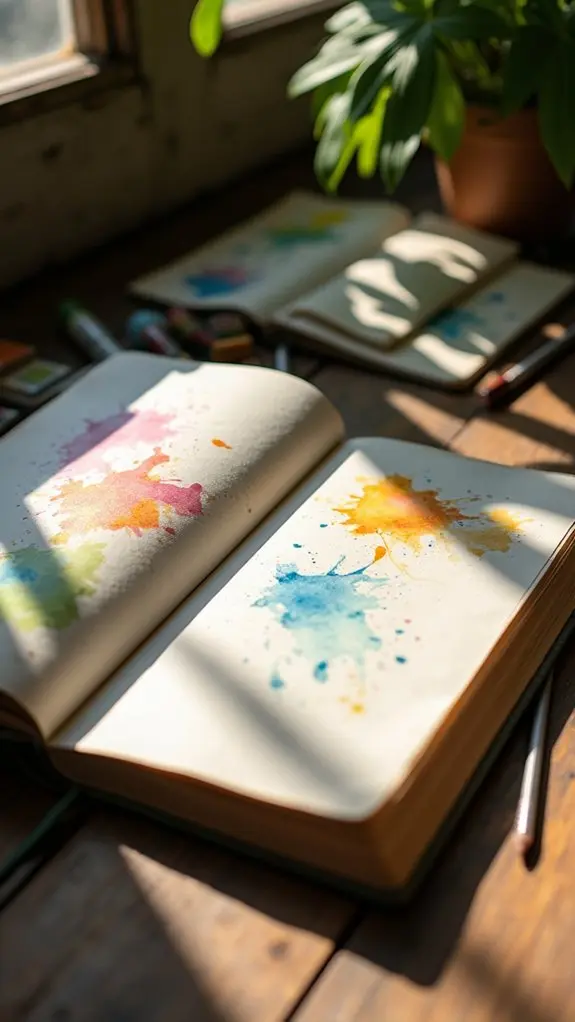
Sometimes a sketchbook page looks a little lopsided or features a squiggle that wasn’t planned, but those so-called “mistakes” can actually steal the show.
Every crooked line or funky shape has its own kind of charm, showing off an artist’s personality in a way perfect drawings can’t.
Celebrate Artistic “Mistakes” Proudly
Let’s be real—every artist has messed up in their sketchbook, and that’s totally worth celebrating.
Artistic freedom means letting go of the pressure to be perfect and actually embracing those so-called mistakes. Danny Gregory says even the weirdest lines or wonky shapes can lead to genius ideas.
Mistake celebration isn’t just about laughing at a lopsided cat drawing, it’s about revealing totally new ways to see and create! Warhol’s rule proves messy experiments can result in awesome breakthroughs.
If artists keep cheering each other on in their flubs, creativity just explodes.
- Surprising “oops” moments inspire new designs
- Flawed sketches create unique personal style
- Experimentation opens up new possibilities
- Sharing goofs builds confidence
- Community support makes mistakes feel less scary
Expressive Value of Wonky
Squiggly lines, off-balance faces, and wobbly shapes—these are the things that can make a sketchbook page truly pop with personality. There’s something almost magical about letting your pencil trip and stumble its way across the paper, creating wonky masterpieces with a life all their own.
Forget about making everything perfect—embracing a little “oops” here and there opens the door to wild, creative freedom. Danny Gregory once said, “If it’s wonky—cool. That’s expressive, that’s art.”
When you’re not stressing every detail, the unexpected happens, and those so-called mistakes become pure awesomeness. Suddenly, you’re not just drawing, you’re inventing new ways for your art to shine.
Growth Through Letting Go
While the urge to make every sketch perfect can be almost impossible to ignore, there’s real magic in just letting go. That’s where artistic liberation and creative surrender begin—when you stop caring so much about getting every line right and just let your ideas flow.
Artists like Danny Gregory say it’s totally okay to move on from “wonky” sketches; each drawing is a step in your journey and none have to be flawless to matter. Dropping perfection lets you have fun and find your true style, plus it takes some pressure off your shoulders.
- Mistakes are often stepping stones to creative breakthroughs.
- Creative freedom blooms when perfection isn’t the goal.
- Each “flaw” can spark fresh ideas.
- Artistic liberation means sketching with joy, not fear.
- Creative surrender opens doors to new styles.
Make Art Anywhere, Using Anything
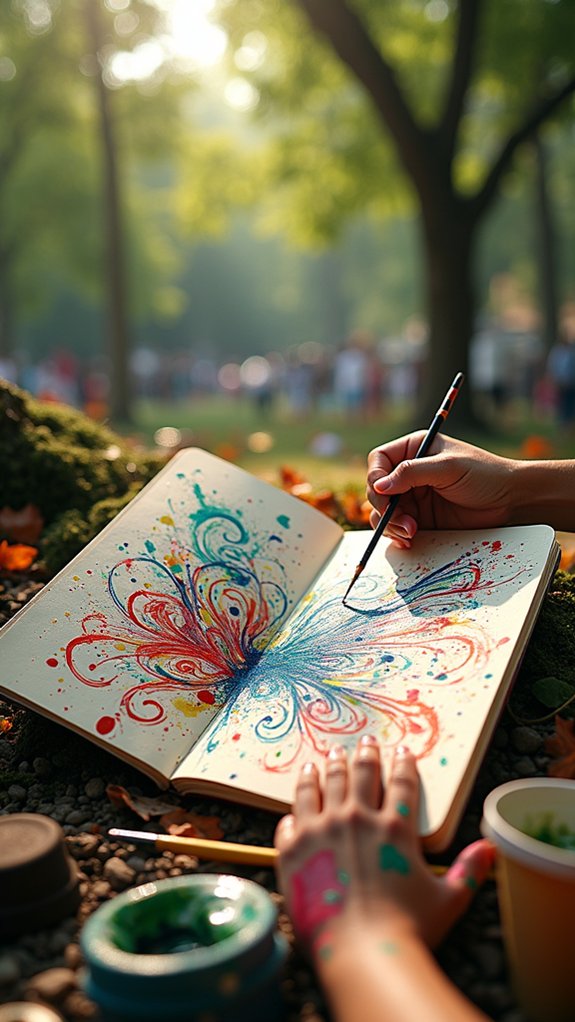
Grab a pen, a piece of scrap paper, or even your old math homework—art doesn’t care where you are or what you use.
Artistic spontaneity can strike anywhere, whether you’re perched at your messy desk or waiting for the bus. Danny Gregory once joked about drawing while you’re on the toilet, proving the best inspiration isn’t picky.
Everyday inspiration is all around: your breakfast toast, your shoes, that weird crack in the wall. The Sketchbook Skool community believes everyone can be creative, and all you need is a willingness to start.
Even a doodle on the edge of a shopping list counts! So next time you feel bored, grab whatever’s nearby and let your imagination run wild.
Art is everywhere, waiting.
Handwriting Is Its Own Kind of Art
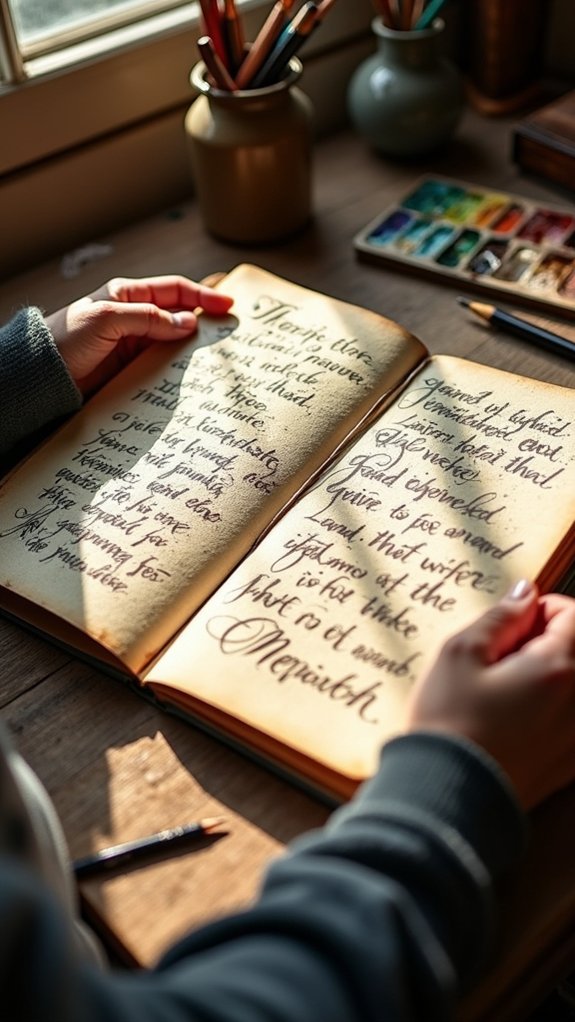
Handwriting can pack a real punch—not just in what it says, but in how it looks, too.
From curly swirls to bold block letters, the way someone writes can show off creativity and even hint at their mood or personality (messy letters on Monday mornings, anyone?).
Each script tells its own story, making quotes in a sketchbook way more personal and fun to look at.
Expressive Power of Handwriting
Even scribbles and funny-looking loops can be more than just random marks—they can explode with personality. Handwriting is a personal superpower, revealing all kinds of benefits for artistic expression and self-discovery. Each curve and squiggle says something unique about the writer, even if it looks a little wild—like hieroglyphics from your own secret language.
When someone grabs a pen instead of a keyboard, their brain wakes up in new ways, thoughts start flowing, and emotions can sneak onto the page. In the world of sketchbooks, handwriting reveals all the messy, honest, and hilarious parts of a person.
Check out some reasons to embrace your own wild handwriting:
- Shows real feelings
- Helps thoughts stand out
- Makes art more personal
- Trains your creativity
- Feels totally freeing
Creative Lettering Techniques
Nobody’s signature messy scrawl or fancy loop is set in stone—there’s a whole world of ways to make writing look awesome, turning letters into art. Sketchbook fans know that creative lettering techniques can totally amplify a page, using all sorts of lettering styles and creative tools. Playing with whimsical fonts, playful layouts, and unique alphabets means every quote pops with personality! Think about mixing bold markers for textural techniques or softer brush pens for smooth ink variations. Pairing quirky design elements with sharp lettering styles opens doors for artistic exploration and even visual storytelling—sometimes a squiggle says more than words! To spark ideas, check out the comparison below:
| Lettering Style | Creative Tool | Design Element |
|---|---|---|
| Brush Lettering | Brush Pens | Swirls |
| Block Alphabet | Gel Markers | Doodles |
| Bubble Letters | Fine Liners | Shadow Effects |
Personal Stories in Script
Flip open a sketchbook, and suddenly, the pages start to buzz with personal stories written in someone’s own unique script. Handwriting isn’t just about words—it’s about letting personality shine through every loop, slant, or squiggly line.
Every flick of the pen captures moments of inspiration, frustration, or pure joy, turning ordinary thoughts into handwritten memories. Personal reflections spill onto the paper, sometimes messy, sometimes neat, but always real.
Here’s why crafting your story in handwriting makes your sketchbook unforgettable:
- Handwriting lets you show off your mood with every stroke.
- Mixing words with doodles makes your art extra special.
- Rereading your notes feels like time travel to past emotions.
- Handwriting boosts creative thinking.
- Your unique style makes each page one-of-a-kind.
Draw Every Day, No Matter Where You Are

Grab a pencil, and let the sketching adventure begin—because drawing can literally happen anywhere, from a cozy bed to a not-so-glamorous bathroom stall, as artist Danny Gregory famously points out.
Sketchbook adventures don’t wait for fancy studios or the “perfect” moment. They happen in line at the grocery store, riding the bus, or chilling at lunch. That’s the magic of spontaneous doodling.
And the more an artist draws—no matter where—the better they get. Having a sketchbook handy means those sudden bursts of inspiration don’t slip away. Maybe that random idea at soccer practice becomes your next masterpiece!
Drawing daily isn’t just about skill; it’s about noticing the world, embracing mistakes, and gaining confidence, one doodle at a time.
Art Is for Everyone
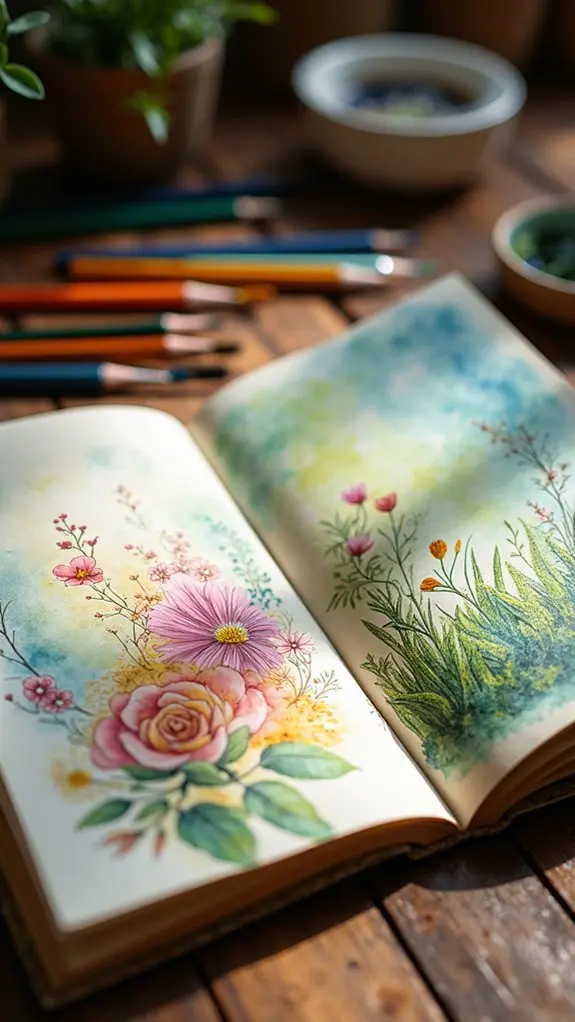
Art. It doesn’t care about your age, your skills, or your background—art is for everyone, no exceptions. That’s what makes art accessibility so important.
Whether your handwriting looks like top-secret spy code or your doodles lean more “alien chic,” it still counts. The #artforall movement is changing the scene, inviting everyone in for a creative burst.
Inclusive creativity simply means there’s no “right” way to express yourself, and everyone gets a seat at the table, crayons included.
- Art breaks barriers—anyone can grab a pencil and start, no permission slip needed.
- Drawing happens anywhere, from buses to treehouses.
- Handwriting becomes art, even if it’s gloriously messy.
- Groups like Sketchbook Skool offer supportive communities.
- Making art is about joy, not perfection.
Share Your Pages, Share Your Light
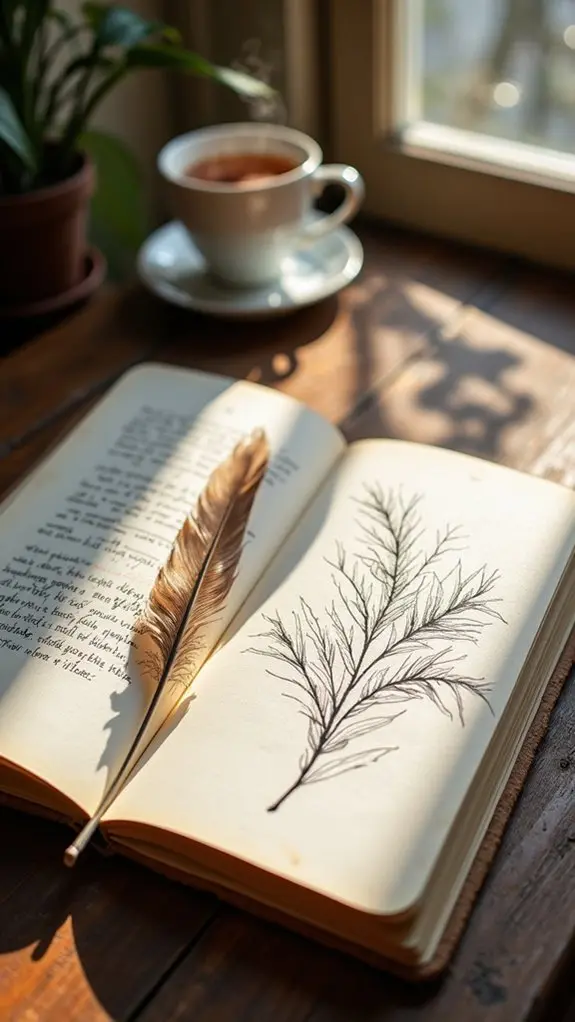
Connection—that’s the secret superpower behind sharing sketchbook pages. When someone opens up their sketchbook to others—whether it’s posting on Instagram or joining The Sketchbook Project—they start an artistic dialogue that wasn’t possible alone.
Suddenly, people all over the world can like, comment, or even ask questions. It’s not just about compliments, either. Sometimes, a bit of encouragement or a well-placed suggestion can give someone the boost they need to keep going.
Sharing sparks inspiration, fuels motivation, and lets people see that no one has to create in isolation. With every shared page, community support grows stronger, making it clear that art is for everyone—not just the so-called “talented” few.
Find Joy in the Playfulness of Your Sketchbook
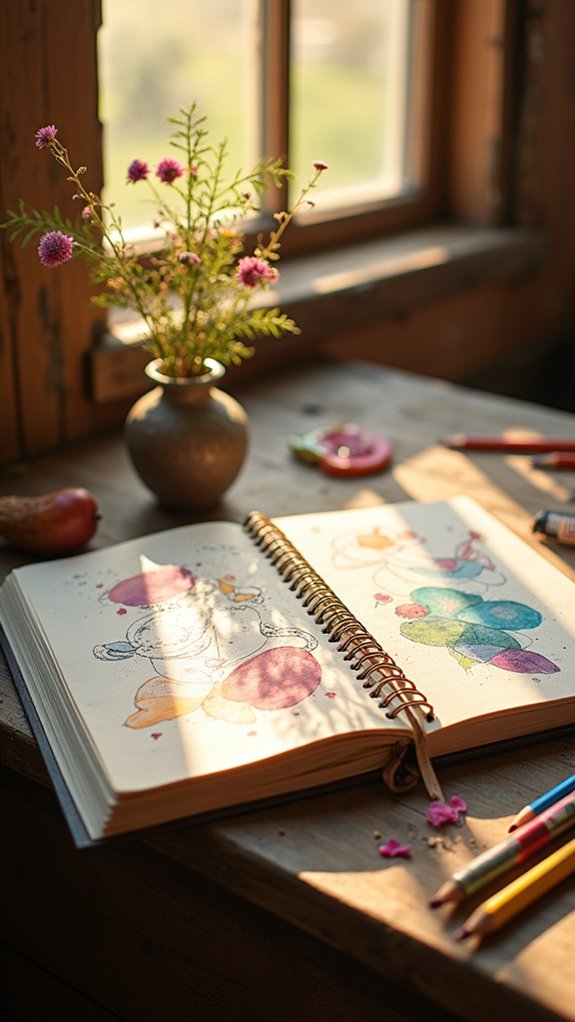
Sometimes, a sketchbook can feel like a playground for the mind, where rules don’t matter and mistakes turn into happy accidents. This is the magic of playful exploration—letting your hands wander, discovering cool ideas, and laughing at the silly doodles that just happen.
Everyone needs spontaneous creation in their life, even if it’s just a quick drawing between homework assignments. Sketchbooks aren’t just about making art, they’re about finding the little joys hiding in your everyday moments.
- Experiment with quick, silly doodles—don’t worry if they look weird!
- Draw whatever grabs your attention, even boring stuff can be fun.
- Fill pages with funny quotes or random thoughts, just because you can.
- Try drawing in unusual places, like sitting on the floor or upside-down.
- Celebrate unexpected results—sometimes they’re the best part!
Your Sketchbook, Your Story
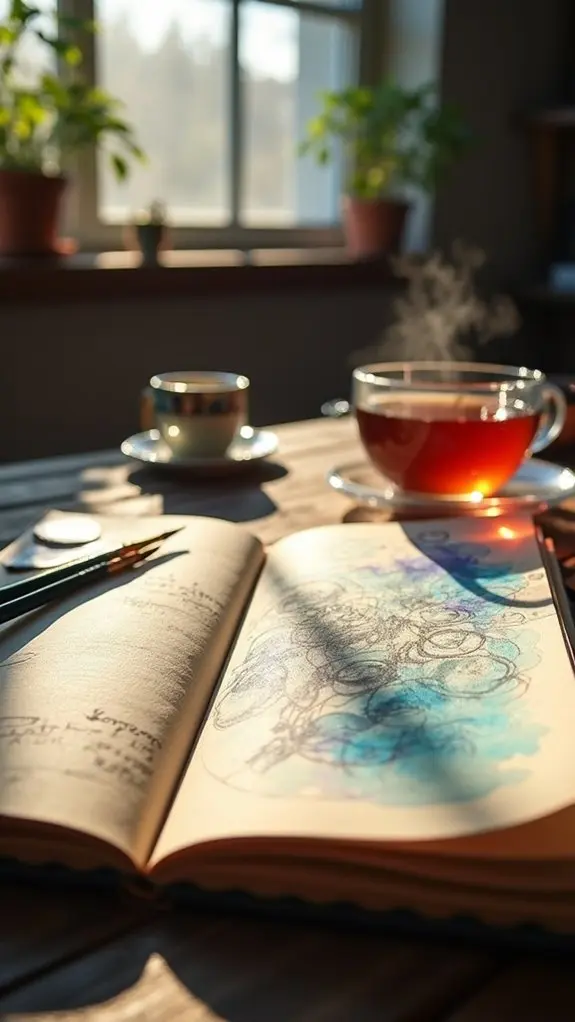
A sketchbook is more than just a collection of empty pages—it’s a secret vault for memories, ideas, and every odd little thought that pops into someone’s head.
Think of it as a diary, but instead of lines filled with words, it’s packed with drawings, doodles, and splashes of color. Each page is a part of your personal narrative, tracking moments, emotions, and those wild inspirations that visit you at midnight.
Artists like Vincent Van Gogh saw their sketchbooks as trusted friends, witnesses to their experiments and mistakes—even their messy spaghetti-scribbles.
Through sketches, a person tells their story, practicing visual storytelling in their own unique way. Your sketchbook doesn’t judge—it actually celebrates every imperfect line and captures your creative adventure forever.
Let Your Curiosity Lead Your Pen
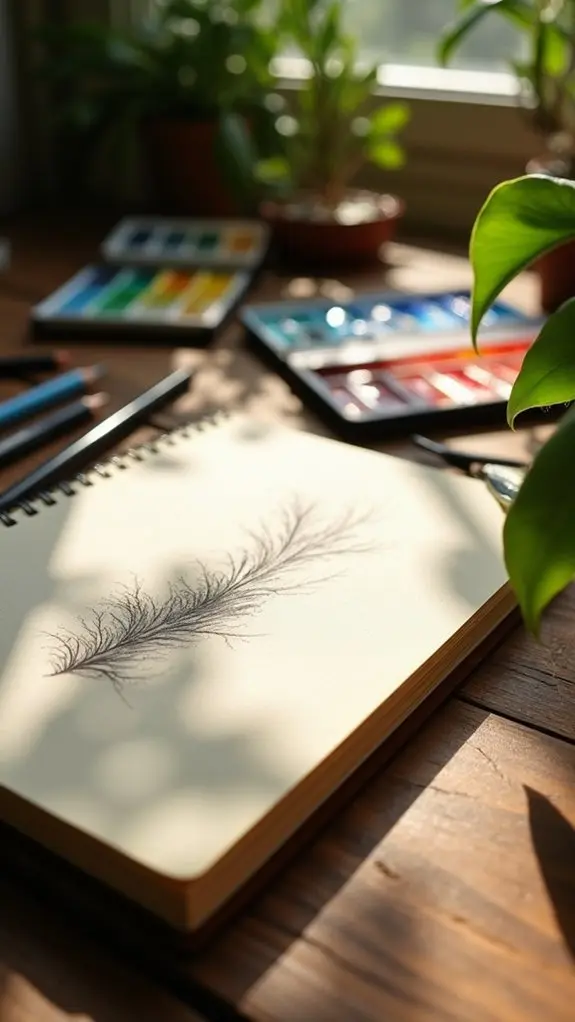
Many of the greatest sketchbook pages begin with just a spark of curiosity—like, what if that slice of pizza had feet? That’s exactly how curiosity exploration works. Instead of sticking to the “usual,” an artist lets their imagination take unexpected turns.
When someone lets curiosity lead their pen, spontaneous expression takes over, and suddenly, weird ideas seem like the best ideas. Artistic growth happens by giving in to that sense of wonder.
- Try sketching something random you spot, like your shoe with wings.
- Mix two animals together and see what happens (spider-dog, anyone?).
- Capture funny moments you saw at lunch.
- Experiment with new art styles or crazy colors.
- Write little notes about what made you curious each day.
Who knows where your pen will go next?
Frequently Asked Questions
What Is a Famous Quote About Sketching?
When asked about a famous quote regarding sketching, one is reminded of Vincent van Gogh’s insight: “Sketchbooks serve as a witness to personal experiences,” capturing evolving sketch styles and creative techniques as artists progress through their journeys.
What to Write on a Sketchbook?
When deciding what to write in a sketchbook, one might include drawing prompts, creative exercises, personal reflections, or favorite quotes. Song lyrics, affirmations, and artistic challenges can also enrich the creative process and foster artistic growth.
What Is a Catchy Quote About Art?
A catchy quote about art can capture the essence of artistic expression and spark creative inspiration. For example, “Art is the journey of a free soul” succinctly conveys the liberating and evocative nature of creativity.
What Should I Put on the First Page of My Sketchbook?
For those considering what to place on the first page, sketchbook inspiration might include an artistic goal, a meaningful quote, a personal affirmation, a simple drawing, or the date—each element setting the creative tone and intention.
Conclusion
A sketchbook is more than just paper—it’s a place for imagination, mistakes, and wild experiments. With the right quote, anyone can feel braver about showing their weird, wobbly lines. The best pages aren’t always pretty, but they’re honest, funny, and totally yours. So, the next time you need a boost, flip back to these quotes. Who knows? Maybe your next doodle will be a masterpiece—or just a really epic mess. Both are pretty cool.

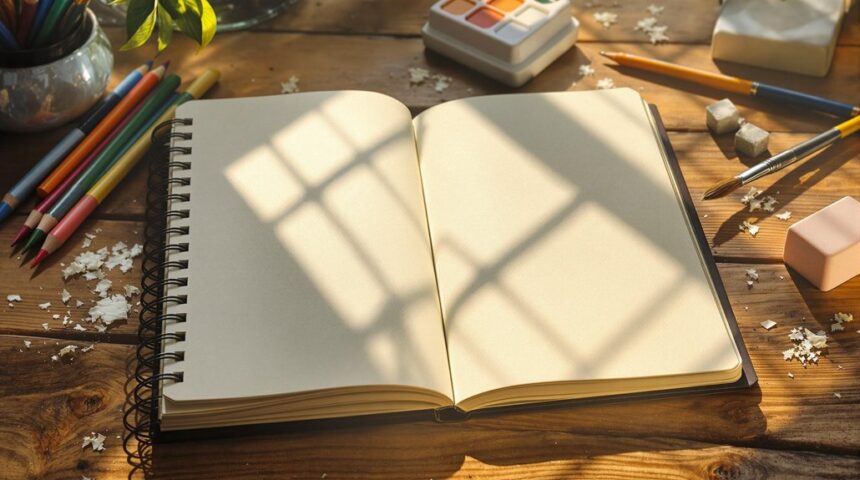
Leave a Reply